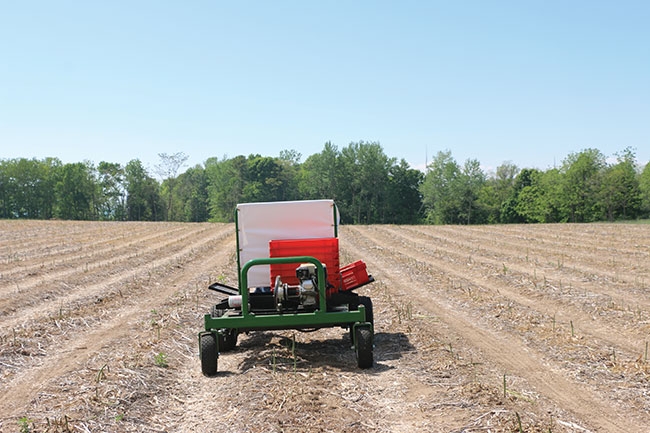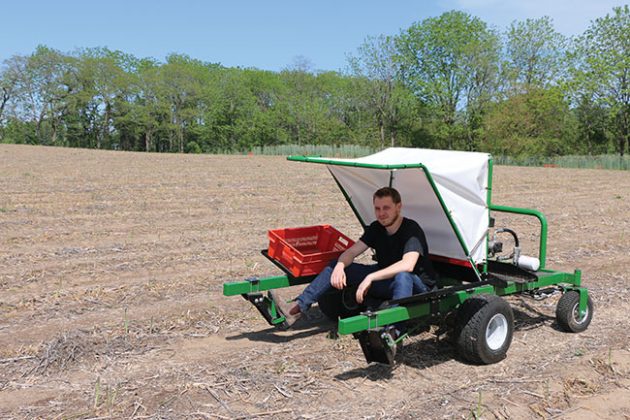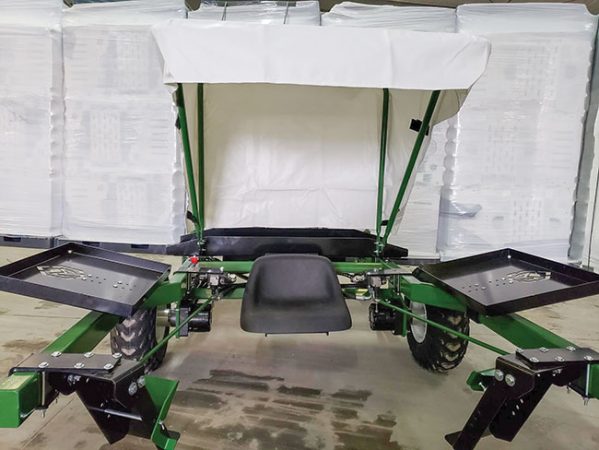
Equipment
Harvesting
Saving man hours with solo-user harvest carts
Many experts believe that robotic harvesters will be doing the work of harvest crews within a decade or 15 years. Until that technology comes online, however, maximizing human efficiency in order to improve harvest quality and decrease labour costs is vital.
July 10, 2019 By Madeleine Baerg
 The solo-user Mantis carts can move quickly between asparagus clumps and can come to a complete stop when necessary to allow the operator time to cut all available spears. Photos courtesy of Made by Frame. Photos courtesy of Made by Frame.
The solo-user Mantis carts can move quickly between asparagus clumps and can come to a complete stop when necessary to allow the operator time to cut all available spears. Photos courtesy of Made by Frame. Photos courtesy of Made by Frame.While farm machinery innovation often means bigger sizes and more complex technology, one Ontario farm is proving smaller and simpler may be the way of the future for harvesting row crops.
Sandy Shore Farms, one of Ontario’s largest growers and packers of asparagus, debuted their single-man harvest carts in their own fields four years ago. Called ‘Mantis’, the solo-user machine is an ultra-simple, gas-powered cart that increases harvest efficiency and decreases wasted time, in turn decreasing cutting crew man hours and even improving product quality.
“In our own operation we harvest between 250 and 300 acres of asparagus on an annual basis,” says Ken Wall, owner and operator of Sandy Shore Farms. “That normally would have required about 200 people annually to harvest. Using the Mantis, we now need 130 people. That’s 70 people I don’t have to find. We’re saving between 35 and 45 per cent on labour costs.”
“We get 150 to 200 per cent more productivity out of the same worker on a single-man harvester compared to a five-man cart,” says East Elgin County asparagus grower Gary Van Leeuwen, who plans to add five more Mantis carts this spring to his farm’s current fleet of 22. “There are still growers out there who won’t believe you when you tell them that but that’s okay; it gives me an edge.”
“We get 150 to 200 per cent more productivity out of the same worker on a single-man harvester compared to a five-man cart,” says East Elgin County asparagus grower Gary Van Leeuwen, who plans to add five more Mantis carts this spring to his farm’s current fleet of 22.
Operated by foot pedals, the Mantis starts and stops at its operator’s demand, ‘leapfrogging’ its way across a field. Unlike the crawling, steady rate of travel of a multi-man harvest cart, the Mantis moves quickly between asparagus clumps but can comes to a complete stop when necessary to allow the operator time to cut all available spears. This lurching motion decreases down time between cuts, reduces missed spears, and results in less damage to immature spears nearly or just emerging from the soil. Meanwhile, the solo nature of the cart eliminates waiting for other crew members and allows for improved employee accountability.
“We can take two single-man carts and cut what we were cutting with one five-man cart,” Van Leeuwen says. “You have to see them operating in the field to see why.”
Five years ago, Wall was chatting with several farmers after a growers’ meeting when talk turned to the upcoming asparagus harvest. In passing, he mentioned his five-man harvest carts, widely considered the best harvest aid available. An older grower – “One of the smartest guys I know,” Wall says – turned to him and said, ‘You’re still using that old harvest technology?’ Wall was a bit taken aback, he admits, not only because he prides his farm on leading the way technologically, but also because he wasn’t aware of another option.
The other farmer quickly clarified, he’d switched to using a three-man cart; basically, a five-man cart with the two outside seats removed. Wall remembers being confused, what benefit could there possibly be from reducing the number of seats? The answer, once the farmer explained the logic, made perfect sense.
“He said, ‘Just think about it. On a harvester, you’re always going to have one person who’s a little slower than the rest. On your five-man harvester, your slow person holds back four people. On my three-man harvester, my slow person only holds back two. And when one of your five-man crew needs a washroom break at the end of a row, you’ve got four people sitting and waiting. I’ve only got two.”
It was, Wall says, a lightbulb moment. Given the incredible cost of labour, not to mention the challenge of finding sufficient bodies for harvest, any efficiency improvement offers significant bottom line results.
Wall immediately went home and called together the Sandy Shore Farms leadership team, his son Marc, brother-in-law Robert Konrad, nephew Daniel Konrad, and lead fabricator Willy Braun. Mere minutes in, the group began to discuss that if a three-man is so much more efficient than a five, wouldn’t a one-man cart be more efficient than a three?
Mere minutes in, the group began to discuss that if a three-man is so much more efficient than a five, wouldn’t a one-man cart be more efficient than a three?
Wall then turned to the internet and found single-man, battery-powered carts manufactured in Italy and Holland. Trialling the Holland-built machines, Wall remembers being blown away by how much more efficient they were than a three- or five- man cart.
“I spent hours in the field with my iPhone out, timing. It was mind-boggling. We were getting anywhere from a 180 to 225 per cent improvement in efficiency. The first time I saw that, I went back to the office and thought that those measurments could not be right. But again, and again and again, the efficiency gains were there.”
Though good in concept, Wall felt that the European-built versions were unable to stand up to the rigours of Ontario’s conditions. He also found them to be unnecessarily complicated, with heavy batteries that proved inconvenient to charge on a large farm. Undeterred, Sandy Shore Farms decided to build their own.
“The first year, we built 30. We wanted them as simple as possible so they’d just keep on running. We put in a simple Honda motor because they last forever, a couple hydraulic pumps. We did everything we could to dumb it down,” Wall says. “I wouldn’t say they’re indestructible, but virtually.”
The following year, Sandy Shore Farms built several hundred units. Most stayed for use on their own farm but, for the first time, the family sold a few Mantis units to other farmers. Since then, demand has ballooned.
Today, Mantis single-man carts are leapfrogging their way across asparagus fields throughout Canada, multiple U.S. states, Mexico, and most recently, New Zealand. Strong interest has also been shown in Europe.
“Accessing enough labour is a growing problem everywhere,” Wall says. “The U.K. especially we think will be a big market. They won’t have access to the same pool of people from eastern Europe that they have in the past because of Brexit so, they’re excited about replacing labour with technology.”
“Accessing enough labour is a growing problem everywhere,” Wall says. “The U.K. especially we think will be a big market. They won’t have access to the same pool of people from eastern Europe that they have in the past because of Brexit so, they’re excited about replacing labour with technology.”
Van Leeuwen admits that having five motors running on single-man carts compared to just one on a five-man cart does burn a little more gasoline and requires somewhat more upkeep and maintenance. But, he says, those costs are outweighed by the benefits by a wide margin.
“The bottom line is there’s not much you can buy in farm machinery that pays for itself in two-and-a-half years on labour savings alone.”
Van Leeuwen also points on one other less obvious benefit to the technology, “On a five-man harvester, it’s hard to know who’s leaving spears behind or cutting short. You’d have to count rows, which is something you rarely do. With the one-man carts, we give each machine two, two-and-a-half acres. I can walk into the field, I can even drive by with the truck window open, and see by the look of the field who’s working hard that day because you know exactly who cut each field. That improves the quality of the harvest a lot.”
If there’s one thing every farmer of labour-intensive crops knows, it’s that keeping your harvest crew happy is key to success. So, what do harvest crews think of the single-operator technology?
“When we’ve taken them off the five-man and put them on the one-man, we haven’t had one employee yet who wanted to go back to the five-man,” Van Leeuwen says. “At first, we questioned whether they’d prefer the social aspect of a five-man harvester, especially those who work with their families. But no, they’re all happier on the one-man rider. They don’t want to go back to the old system. I don’t either, that’s for sure.”
“When we’ve taken them off the five-man and put them on the one-man, we haven’t had one employee yet who wanted to go back to the five-man,” Van Leeuwen says.
Many tech experts believe that robotic harvesters will be doing the work of harvest crews within a decade or 15 years. Until that technology comes online, however, maximizing human efficiency in order to improve harvest quality and decrease labour costs is vital.
“I think we’re going to see dramatic improvements in efficiency over the coming years,” Wall says. “We’ve been forced into it with all the increasing costs, especially the 22 per cent wage increase. Growers are either going to get out of this industry or adapt to survive, which is where you’re going to see the use of technology coming in. Will there be other uses for this one-man technology? There’s no question. We’re excited to work with that.”
Sandy Shore Farms is already working on adapting the Mantis technology to suit other applications, from hand weeding, to simplifying manual labour throughout the growing season in a variety of row crops. Wall expects strawberry farmers to be next in line for Mantis harvesters given the current challenges of hand harvesting that labour-intensive crop.
But no matter how many applications the Mantis ultimately fills, there’s only one that is nearest and dearest to him, “We’re mostly excited that we’ve been able to adapt this technology to work on our own farming operation. First and foremost, we are asparagus growers,” he says.
Print this page

